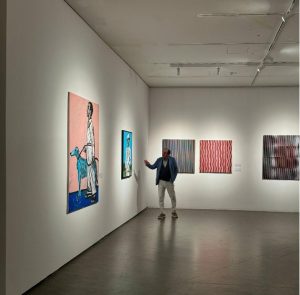“Photo by Michalina Franasik from the exhibition “The New Generation and Classics from the Wojtek Fibak Collection” in CSW in Torun
Introduction
Since 2023, new Polish legislation has led to the creation of over 1,000 private family foundations, sparking unprecedented growth in this sector. This reflects a strong desire among wealthy Poles to protect their wealth and art collections for future generations. This article will explore the growing demand for wealth managers in Poland, the evolving art market, and shifts in collectors’ tastes, highlighting key trends and challenges investors face.

Polish Art Collecting
Historical & Business context
The origins of art collection in Poland trace back to the 16th century during the reign of Sigismund the Old and his Italian wife, Bona Sforza, who made significant investments in culture. The 17th century saw the Vasas Dynasty elevate art collecting as a means of aligning with Western European cultural standards. However, the Polish gentry often viewed art collecting as an activity of the upper class, linked to “monarchical absolutism,” a perception that sometimes still influences Polish art collection today.
A turning point came in the late 18th century with the loss of Polish independence under Augustus II. Despite his passion for Old Masters, his reign contributed to Poland’s decline as a European power, forcing many artists to seek opportunities abroad. This trend continued through the 19th and 20th centuries, as political exile and the quest for career advancement led Polish artists to find success in international markets. As Stanislaw Lec, a Polish aphorist and poet, once said in his collection of aphorisms, “The discipline of art requires freedom.” It is therefore understandable that the Polish art market began to take shape only in 1989, following the fall of the communist regime and the transition to a free market economy. The post-war period saw a continuation of this emigration due to political reasons. These historical events significantly shaped the evolution of art collection in Poland and how Polish collectors think nowadays. Over the past 30 years, it has been growing consistently, with total sales of art and antiques reaching approximately PLN 368 million [USD 94 million] in 2023.

Current Trends in the Polish Art Market
In recent years, the Polish art market has undergone a significant shift in both its collector profiles and the art periods in demand. This period saw the rise of major auction houses like DESA Modern and AgraArt, which achieved considerable success through the sale of works by Old Polish Masters such as for example Jan Matejko, Jacek Malczewski and Wojciech Kossak. However, as wealth has transferred across generations, the market has evolved. This shift has resulted in an increased emphasis on contemporary art. According to the OneBid 2023 art market report, modern, contemporary, and ultra-contemporary paintings accounted for nearly 51% of the market turnover, while Impressionist, Pre-War, and Historical painting (Sztuka Dawna) made up only 29%. Names of contemporary artists who are highly collected include are: from so called the Older Generation, the “Classics” Wojciech Fangor, Magdalena Abakanowicz, Andrzej Wróblewski, Leon Tarasiewicz. From the “New Generation”, the natable names Ewa Juszkiewicz, Karolina Jabłońska, Julian Jakub Ziółkowski, Agata Kus and Agata Bogacka.

Future possibilities
While the Polish market remains predominantly focused on Polish artists, there has recently been a noticeable shift in the nationalities of artists gaining prominence. As Marzena Karpinska, sales director of Polswiss Art auction house said “we expect, especially as a certain unification of the Polish market with the foreign one.” There is a possibility that the Polish art market may become more open to international influences in the future. However, for now, there remains a strong sense of patriotism and pride in collecting works by Polish artists, a sentiment likely shaped by the country’s complex history.
New developments – Polish Family Foundations
In recent years, the Polish art market has witnessed a growing interest in wealth management strategies that not only preserve family capital but also foster cultural legacies. One such strategy gaining traction is the establishment of family foundations, a legal entity formalised by the Act of 26 January 2023 on the family foundation. This act enables families to accumulate, manage, and transfer wealth across generations while pursuing specific goals such as education or art collection.
As one Polish collector I interviewed observed, the primary motivation for setting up a family foundation in Poland is “to accumulate family capital for future generations.” It is platform for intra-family activities, which not only involves multiple generations but also enhances the family’s appreciation for art. Establishing a foundation is a relatively straightforward process, beginning with a notarial deed and followed by registration with the National Court Register, requiring a minimum capital of PLN 100,000 [USD 26,000].
Conclusion
As the Polish art market grows, family foundations and shifting collector preferences offer new opportunities for wealth preservation and cultural investment. With collection management and art foundations still new in Poland, there’s a rising demand for experts to guide collectors. However, navigating regulatory challenges, market transparency, and risks will be crucial for sustained growth.
References
Bojar-Stefańska Karolina and Andrzej Sałamach, “Polska Fundacja Rodzinna W Liczbach – Panasiuk & Partners”, [Polish Family Foundation In Figures – Panasiuk & Partners ” Panasiuk & Partners], Accessed on June 27th 2024. https://panasiuk.com.pl/polska-fundacja-rodzinna-w-liczbach/
OneBid, “Aukcje Sztuki, Malarstwa i Numizmatyki 2023”, [Art, painting and numismatic auctions 2023] Accessed on August 10th 2024.
https://onebid.pl/pl/offer/item/0/0/1/13949/raport-polskiego-rynku-aukcyjnego-2023#:~:text=%22W%202023%20r.,czyli%20nieca%C5%82e%20368%20mln%20z%C5%82.
Private Polish Collector. “Wealth Management in the Emerging Polish Art Market: Navigating Opportunities and Challenges on the art market”. Interview by Interviewer Michalina Fraansik. ArtTactic Editorial 2024.
Piotrkow Trybunalski GOV, “Rejestr Fundacji Rodzinnych – Sąd Okręgowy W Piotrkowie Trybunalskim 2023.” Accessed on August 16th 2024.
https://piotrkow-tryb.so.gov.pl/rejestr-fundacji-rodzinnych,m,mg,305
Zorloni Alessia, Art Wealth Management: Managing Private Art Collections, January 2016.
DOI:10.1007/978-3-319-24241-5
Are you a student or recent graduate eager to contribute your voice to ArtTactic’s Editorial vision? We’d love to hear from you!
Reach out to our Commissioning Editor, Margaret Hong (margaret@arttactic.com) for more information.

